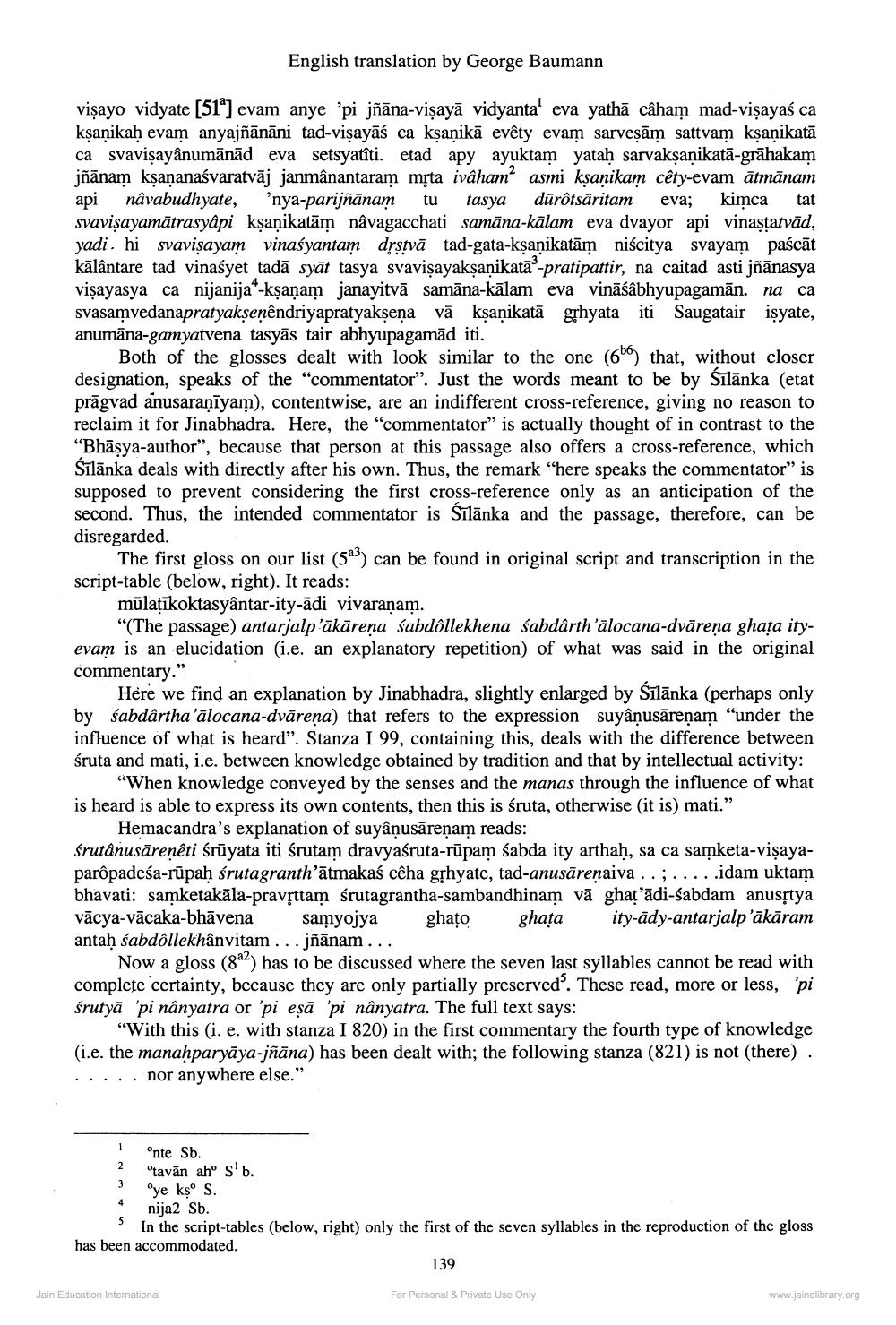________________
English translation by George Baumann
viņayo vidyate (51°) evam anye 'pi jñāna-viṣayā vidyanta' eva yathā câham mad-visayas ca ksaņikah evam anyajñānāni tad-visayāś ca ksaņikā evêty evam sarvesām sattvam kşaņikatā ca svavisayânumānād eva setsyatîti. etad apy ayuktam yataḥ sarvaksanikatā-grāhakam jñānam kşananaśvaratvāj janmânantaram msta ivaham asmi ksanikam cêty-evam ātmānam api nâvabudhyate, 'nya-parijñānam tu tasya dūrôtsäritam eva; kimca tat svavişayamātrasyâpi kşaņikatām nâvagacchati samāna-kālam eva dvayor api vinastatvād, yadi. hi svavisayam vinasyantam dystvā tad-gata-kşanikatām niścitya svayam paścāt kālântare tad vinaśyet tadā syāt tasya svavişayakşanikatā -pratipattir, na caitad asti jñānasya visayasya ca nijanija-kşaņam janayitvā samāna-kālam eva vināšâbhyupagamān. na ca svasamvedanapratyakşenêndriyapratyakşeņa vā kşaņikatā grhyata iti Saugatair isyate, anumāna-gamyatvena tasyās tair abhyupagamād iti.
Both of the glosses dealt with look similar to the one (60) that, without closer designation, speaks of the "commentator". Just the words meant to be by Silānka (etat prāgvad anusaranīyam), contentwise, are an indifferent cross-reference, giving no reason to reclaim it for Jinabhadra. Here, the "commentator" is actually thought of in contrast to the “Bhāsya-author", because that person at this passage also offers a cross-reference, which Sīlānka deals with directly after his own. Thus, the remark "here speaks the commentator" is supposed to prevent considering the first cross-reference only as an anticipation of the second. Thus, the intended commentator is Sīlānka and the passage, therefore, can be disregarded.
The first gloss on our list (593) can be found in original script and transcription in the script-table (below, right). It reads:
mūlatīkoktasyântar-ity-ādi vivaranam.
"(The passage) antarjalp'ākāreņa sabdôllekhena sabdârth'ālocana-dvāreņa ghata ityevam is an elucidation i.e. an explanatory repetition) of what was said in the original commentary."
Here we find an explanation by Jinabhadra, slightly enlarged by Silānka (perhaps only by śabdârtha 'ālocana-dvāreņa) that refers to the expression suyâņusāreņam "under the influence of what is heard". Stanza I 99, containing this, deals with the difference between śruta and mati, i.e. between knowledge obtained by tradition and that by intellectual activity:
"When knowledge conveyed by the senses and the manas through the influence of what is heard is able to express its own contents, then this is śruta, otherwise (it is) mati."
Hemacandra's explanation of suyâņusāreņam reads: śrutânusārenêti śrūyata iti śrutam dravyasruta-rūpam sabda ity arthah, sa ca samketa-visayaparôpadeśa-rūpaḥ śrutagranth'ātmakaś cêha gļhyate, tad-anusāreņaiva ..;.....idam uktam bhavati: samketakāla-pravsttam śrutagrantha-sambandhinam vā ghat'ādi-sabdam anusstya vācya-vācaka-bhāvena samyojya ghato ghata ity-ādy-antarjalp'ākāram antaḥ śabdôllekhânvitam ... jñānam...
Now a gloss (892) has to be discussed where the seven last syllables cannot be read with complete certainty, because they are only partially preserved. These read, more or less, 'pi Śrutyā 'pi nânyatra or 'pi eşā 'pi nânyatra. The full text says:
"With this (i. e. with stanza I 820) in the first commentary the fourth type of knowledge (i.e. the manahparyāya-jñāna) has been dealt with; the following stanza (821) is not (there). ..... nor anywhere else."
'nte Sb.
Stavān aho s'b. 3 ye kso S.
nija2 Sb.
In the script-tables (below, right) only the first of the seven syllables in the reproduction of the gloss has been accommodated.
139
Jain Education International
For Personal & Private Use Only
www.jainelibrary.org




